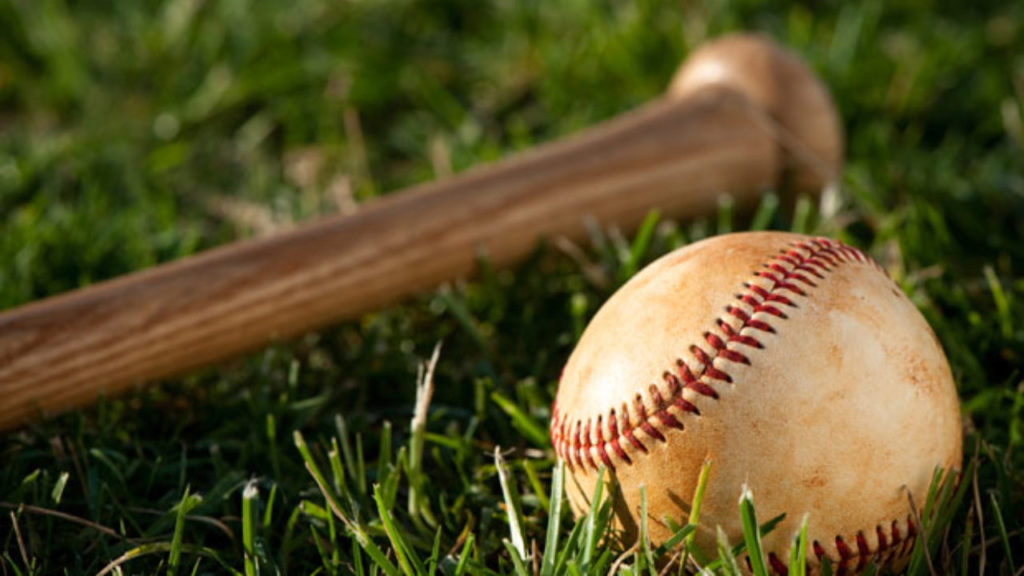Table of Contents
THE NEGRO LEAGUES AND JACKIE ROBINSON
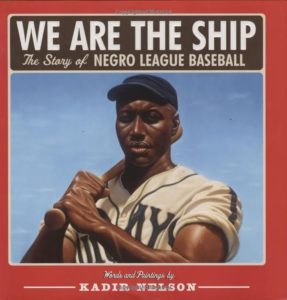
|
Kadir Nelson’s We Are the Ship: The Story of Negro League Baseball (Hyperion, 2008) takes its title from a quote by the League’s founder: “We are the ship; all else is the sea.” The book, gorgeously illustrated with paintings, is divided into nine “innings,” beginning with the formation of the League in 1920 and ending with Jackie Robinson’s historic entry into white major league baseball. For ages 8 and up. |
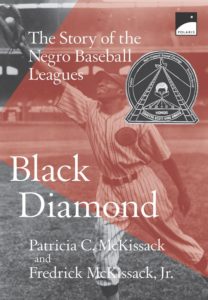 |
Patricia and Fredrick McKissack’s Black Diamond: The Story of the Negro Baseball Leagues (Scholastic, 1998) is an excellent history emphasizing the role of baseball in the quest for racial equality, illustrated with period photographs. For ages 10-14. |
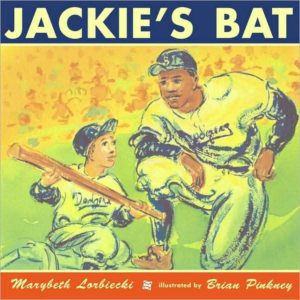
|
Marybeth Lorbiecki’s Jackie’s Bat (Simon & Schuster Books for Young Readers, 2006) is a fictionalized account of Jackie Robinson’s first season with the Brooklyn Dodgers, as told by the young batboy, Joey, whose father insists that a white boy has no business serving a black man. Increasingly impressed by Robinson’s behavior, talent, and fortitude, however, Joey eventually learns the error of his ways. For ages 5-9. |
| Beyond Baseball, a lesson plan to accompany Jackie’s Bat, has discussion questions, instructions for a game of “Fact Baseball,” a bibliography, and activities, among them writing a letter to Jackie Robinson and making a Robinson-related collage. | |
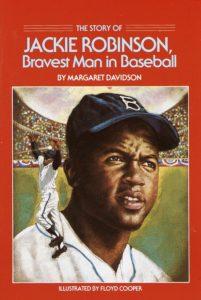 |
Margaret Davidson’s The Story of Jackie Robinson: Bravest Man in Baseball (Yearling, 1987) is a chatty and interesting 96-page biography for ages 8-11. |
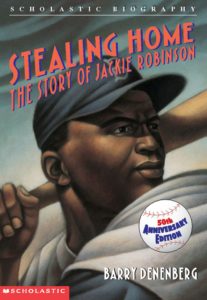 |
Barry Denenberg’s Stealing Home: The Story of Jackie Robinson (Scholastic, 1990) is a 128-page biography, illustrated with black-and-white photographs, for ages 9-12. |
| From Scholastic, Breaking Barriers is a five-part study unit on Jackie Robinson’s career, accomplishments, and impact on life in America. A prime feature is an annual essay contest for grades 4-8. | |
| Baseball, Race Relations, and Jackie Robinson is a lesson plan based on primary sources from the Library of Congress American Memory collection, targeted at grades 9-12. | |
| Also from the Library of Congress, see Baseball, the Color Line, and Jackie Robinson. | |
| Crayola’s Jackie Robinson at Bat has instructions for making a papercraft “triarama.” | |
| Also see Black History. |
MORE BASEBALL HISTORY
Whoever wants to know the heart and mind of America had better learn baseball. Jacques Barzun
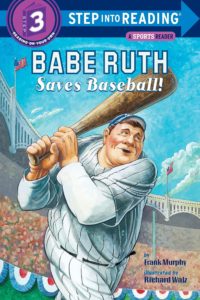 |
Frank Murphy’s Babe Ruth Saves Baseball! (Random House Books for Young Readers, 2005) is the charmingly presented story of how Babe Ruth – with his prodigious talent for hitting home runs – managed to redeem baseball following the Black Sox scandal during the World Series of 1919. For ages 5-8. |
| See The Black Sox Scandal for more information on the 1919 debacle. | |
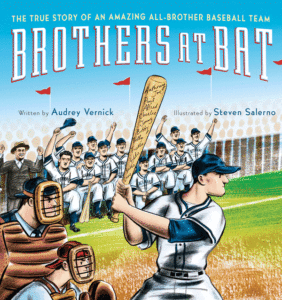
|
Audrey Vernick’s Brothers at Bat (Clarion Books, 2012) is the (true) picture-book story of the Acerra family who lived in Long Branch, New Jersey, in the 1930s – and who had sixteen children, twelve of them boys who loved to play baseball. With the help of their father, the boys formed an all-brother baseball team that went on to be inducted into the Baseball Hall of Fame. For ages 5-8. |
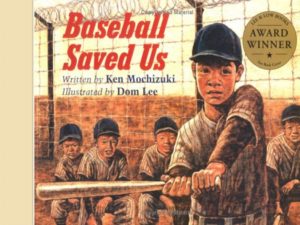
|
In Ken Mochizuki’s Baseball Saved Us (Lee & Low Books, 1995), a Japanese-American boy in an internment camp during World War II finds that his skill at baseball helps him cope with captivity and prejudice. For ages 6-10. |
| Baseball Saved Us is a guide to accompany the book, with background information, discussion questions, research projects, and a supplementary reading list. | |
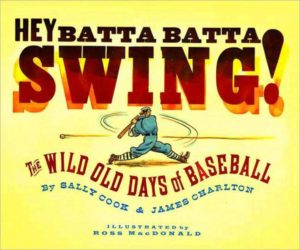
|
Hey Batta Batta Swing! by Sally Cook and James Charlton (Margaret K. McElderry Books, 2007) is a fascinating history of early baseball and baseball players, illustrated with vintage-cartoon-style drawings by Ross MacDonald, and peppered with intriguing trivia and a terrific array of early baseball slang. (Discover the meaning of crank, Uncle Charlie, can of corn, gapper, and frozen rope.) For ages 7-12. |
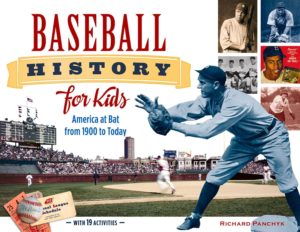
|
Richard Panchyk’s Baseball History for Kids (Chicago Review Press, 2016) traces the history of baseball from 1900 to the present, with a timeline, period photos, and 19 hands-on activities, among them designing a team logo, learning to calculate a batting average, and making a batch of Cracker Jacks. For ages 9-13. |
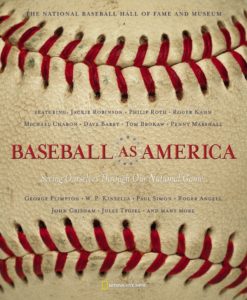 |
From the National Baseball Hall of Fame and National Geographic, Baseball As America (National Geographic, 2005) is a photo-packed survey of baseball in American history and culture. See pictures of the famous Honus Wagner T206 baseball card, Shoeless Joe Jackson’s shoes, a Barnum & Bailey circus poster of baseball-playing elephants, and much much more. For all ages. |
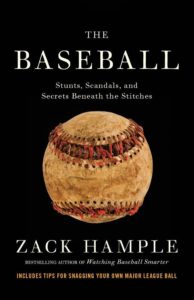
|
Zack Hample’s The Baseball (Anchor Books, 2011) is a collection of ball-related history, lore, trivia, and disasters. Did you know, for example, that Babe Ruth once tried to catch a ball dropped from an airplane? That there’s a thousand feet of yarn inside every ball? There’s even (for the morbid) a chapter on “Death by Baseball.” Hample – who is a master of the art of ball-snagging – also includes helpful hints for snagging baseballs of your own to take home from the game. For teenagers and adults. |
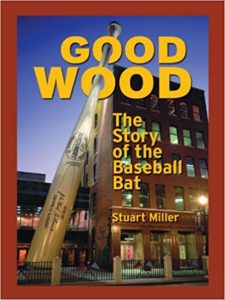 |
For everything you could possibly want to know about the baseball bat, see Stuart Miller’s Good Wood: The Story of the Baseball Bat (ACTA Publications, 2011). For teenagers and adults. |
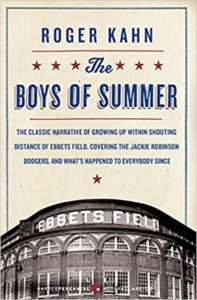 |
Sports writer Roger Kahn’s The Boys of Summer (Harper Perennial Modern Classics, 1996) is a memoir of Kahn’s life with the Brooklyn Dodgers in the historic years of Jackie Robinson. Often cited as the best baseball book ever. For teenagers and adults. |
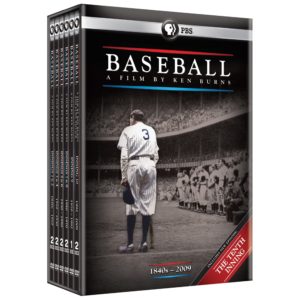
|
For baseball- and history-lovers – either or both – Ken Burns’s acclaimed PBS series Baseball, originally presented in nine (now updated to ten) innings/episodes, traces baseball from its origins in the 1840s to the present day. The website has episode descriptions, biographies of famous ballplayers, a baseball timeline, a multiple-choice quiz, a resource list, and a terrific list of associated lesson plans, most targeted at middle-grade-level students. |
| The Library of Congress American Memory collection includes over 2000 vintage baseball cards. | |
| The National Baseball Museum in Cooperstown, NY, has a “This Day in Baseball History” feature, a list of the members of the Baseball Hall of Fame, and more. | |
| Teacher Vision’s Baseball Teaching Resources has a list of baseball-related lesson plans, book summaries, and printable activity sheets, variously covering baseball in history, literature, biography, math, and social studies. (Some features available only to subscribers.) |
